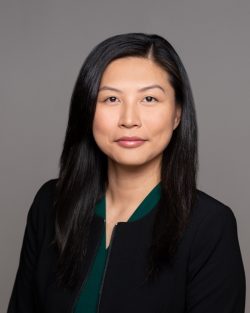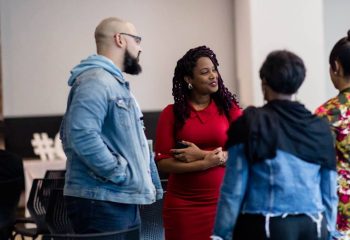Knight Foundation, Surdna Foundation and Comcast NBCUniversal invest in Center for Black Innovation’s mission to serve as a research center and training hub for black entrepreneurs nationwide.
Miami, FL — (November 12, 2020) — The John S. and James L. Knight Foundation, the Surdna Foundation and Comcast NBCUniversal announced today $2.1 million in investments to support the Center for Black Innovation’s mission to increase Black entrepreneurship in Miami and throughout the nation. Previously known as Code Fever Miami, the center will provide startup and investor education for Black tech entrepreneurs in cities across the nation.
How the Center works
The new investment includes $1.5 million from Knight, $350,000 from Surdna and $250,000 from Comcast NBCUniversal. They will enable the nonprofit Center for Black Innovation to:
- focus on supporting Black startups, providing investor education, and conduct ongoing data collection to better understand how Black tech entrepreneurs participate in local startup ecosystems;
- launch new programming that includes angel investor training and venture capital investor matchmaking sessions;
- and offer a mix of in-person and virtual courses at the center’s headquarters in Miami’s Overtown neighborhood, with additional programming and events taking place in cities across the nation.
In the past, the Center’s founders have helped Black-led startups such as CaribShopper, IcanFitness, Adwizar, Beloved Box and GovLia build relationships with customers, funders and mentors.
“We have rebranded as the Center for Black Innovation to reflect the expanded programming for the many Black innovators in Miami and across the U.S.,” said Felecia Hatcher, who founded Code Fever along with Derrick Pearson in 2013. “With this investment, the center will also serve as a research center committed to creating equitable pathways for Black founders to thrive and build capital.”
In 2013, Hatcher and Pearson created Code Fever to address a lack of entrepreneurial opportunities in Black communities across the U.S. Knight has supported the organization since its inception with a total of $1.6 million in funding for programs benefiting Miami’s entrepreneurs of color, such as BlackTech Week and the Young Coders Academy.
This is Surdna’s first investment in the Center focused on creating national programming and infrastructure. Today’s joint investment supports the Center’s vision of growing the number of Black entrepreneurs who are successful in establishing startups in Greater Miami and across the nation.
Creating inclusive entrepreneurship
“Knight has long been committed to helping Miami grow as a place where everyone can benefit from the promises that innovation and entrepreneurship offer, including expanded individual opportunity and economic inclusion,” said Raul Moas, director for Knight’s Miami program.
Knight’s Miami program is focused on growing a startup community that’s open to all and through which innovators can connect and create lasting change. Surdna’s Inclusive Economies program focuses on investing in business development for communities of color and increasing community voice in economic policy and planning.
“This partnership creates the opportunity for the Center for Black Innovation to be a training ground for other communities across the nation to build and strengthen their Black tech ecosystems,” said Patrice Green, program officer for Surdna’s Inclusive Economies program.
Comcast NBC Universal has long been committed to addressing digital inequities so that all Americans have the opportunity to succeed in an increasingly digital world. This investment in the Center is part of the company’s multi-year $100 million commitment to fight injustice and inequality and will help create access to networks, training and capital for Black founders.
“Comcast NBCUniversal has joined with Code Fever Miami and Black Tech Mecca on their work to develop the next generation of Black innovators and entrepreneurs, and we are proud to expand this partnership with our support of the Center for Black Innovation,” said Dalila Wilson-Scott, executive vice president and chief diversity officer at Comcast NBCUniversal.
As part of its expansion, the Center for Black Innovation recently acquired Black Tech Mecca, a think tank that uses data to assist Black practitioners in finding opportunities in the global tech sector. The acquisition will allow for further research to identify how Black innovators participate in local economies and to identify areas for improvement.
About the John S. and James L. Knight Foundation
Knight Foundation is a national foundation with strong local roots. We invest in journalism, in the arts, and in the success of cities where brothers John S. and James L. Knight once published newspapers. Our goal is to foster informed and engaged communities, which we believe are essential for a healthy democracy.
About the Surdna Foundation
The Surdna Foundation seeks to foster just and sustainable communities in the United States— communities guided by principles of social justice and distinguished by healthy environments, inclusive economies, and thriving cultures. For over five generations, Surdna has been governed largely by descendants of John Andrus and has developed a tradition of innovative service for those in need of help or opportunity. Learn more at www.surdna.org.
About Comcast Corporation
Comcast Corporation is a global media and technology company with three primary businesses: Comcast Cable, NBCUniversal, and Sky. Comcast Cable is one of the United States’ largest high-speed internet, video, and phone providers to residential customers under the Xfinity brand, and also provides these services to businesses. It also provides wireless and security and automation services to residential customers under the Xfinity brand. NBCUniversal is global and operates news, entertainment and sports cable networks, the NBC and Telemundo broadcast networks, television production operations, television station groups, Universal Pictures, and Universal Parks and Resorts. Sky is one of Europe’s leading media and entertainment companies, connecting customers to a broad range of video content through its pay television services. It also provides communications services, including residential high-speed internet, phone, and wireless services. Sky operates the Sky News broadcast network and sports and entertainment networks, produces original content, and has exclusive content rights. Visit www.comcastcorporation.com for more information.
Center for Black Innovation
Communications: Suzan McDowel, [email protected] or 305.490.9145
Knight Foundation
Communications Officer: Raul Garcia, [email protected] or 786.452.6674
Surdna Foundation
Communications: Elizabeth Cahill, [email protected] or 973.900.3897
Comcast NBCUniversal
Communications: Cia Williams, [email protected] or 267.592.1065
Image (top) by the Center for Black Innovation.



